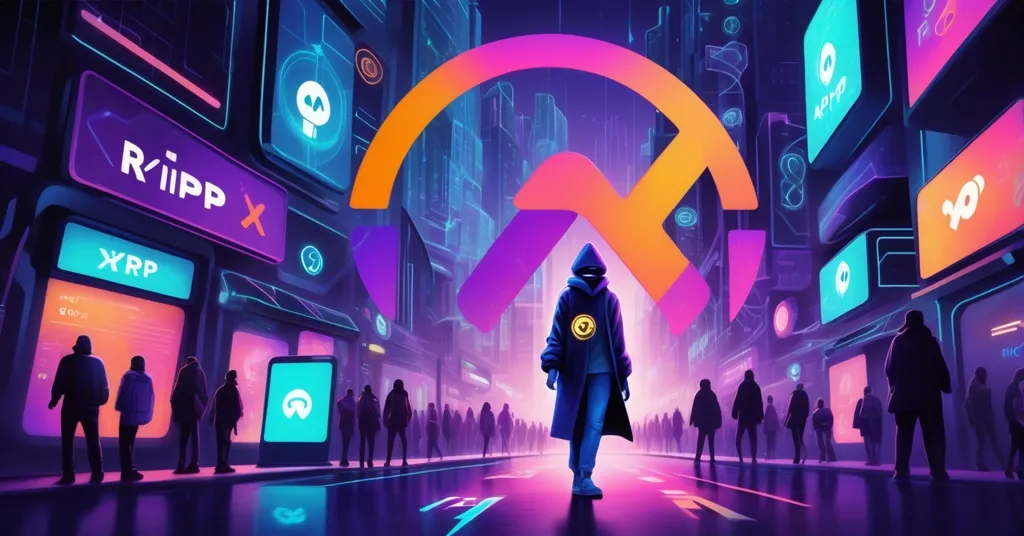XRP at $2.93: Gemini-Mastercard Hype Clashes with Technical Hurdles

XRP Price Analysis at $2.93: Gemini-Mastercard Crypto Rewards Card Hype Faces Technical Roadblocks
XRP, the native token of Ripple’s XRP Ledger, finds itself at a crossroads with a price stuck at $2.93 amid a flashy new partnership. Gemini’s rollout of an XRP Mastercard credit card has propelled the exchange past Coinbase in app rankings, sparking excitement for mainstream adoption. Yet, ChatGPT’s technical breakdown reveals a coin grappling with neutral-to-bearish signals—will partnership momentum break through the charts’ stubborn resistance, or is XRP doomed to linger in limbo?
- Price Consolidation: XRP stalls at $2.9293 with a modest 2.48% gain, showing mixed technical signals.
- Gemini-Mastercard Impact: A new XRP rewards card boosts Gemini’s ranking and fuels institutional interest.
- Fundamental Push: Ripple’s banking license rumors and RLUSD stablecoin progress add long-term potential.
XRP Price: Stuck in Neutral
Let’s get straight to the numbers: XRP is hovering at $2.9293, a slight 2.48% bump from its opening price of $2.8584. Its intraday trading range spans a tight 3.2%, with a low of $2.8459 and a high of $2.9409. Diving into the technicals, the picture isn’t exactly inspiring. The Relative Strength Index (RSI), a momentum indicator, sits at 46.01—neither overbought nor oversold, just a big fat “meh.” For the uninitiated, RSI measures price speed and change on a scale of 0 to 100; below 30 often hints at a potential bottom, while above 70 suggests a peak. At 46, XRP’s momentum is as decisive as a coin flip. For deeper insights into these metrics, check out this detailed XRP price analysis.
Looking at moving averages—tools that smooth out price trends to spot direction—XRP shows a split personality. It’s trading below its 20-day Exponential Moving Average (EMA) of $3.0229 and 50-day EMA of $2.9463, signaling short-term weakness. Yet, it holds above its 100-day EMA of $2.7567 and 200-day EMA of $2.4857, offering a glimmer of longer-term support. The Moving Average Convergence Divergence (MACD), which tracks trend changes, clocks in at a bearish -0.0248, hinting that sellers might still have the upper hand. Meanwhile, the Average True Range (ATR) at 2.3507—a gauge of price swings—suggests a big move could be brewing, up or down. Charts don’t lie, but they sure love to tease. Community discussions on platforms like Reddit offer further technical analysis of XRP’s RSI and MACD trends.
Volume, however, paints a rosier picture. With 84.46 million XRP traded recently, there’s clear institutional muscle behind the scenes. XRP’s market cap stands at $174.3 billion (down 0.86%), with a 24-hour trading volume of $7.3 billion (down 8.48%). It claims a 4.57% slice of the total crypto market—basically, the share XRP represents among all digital assets—up a smidge by 0.09%. Of its total 100 billion token supply, 59.48 billion are circulating, pegging the fully diluted valuation at $293.3 billion. For context, XRP remains 23.66% below its 2018 all-time high of $3.84, but it boasts a staggering 104,564% gain since its 2014 lows. Altcoins, folks—they’re a rollercoaster. For a broader understanding of XRP and its technology, explore this comprehensive overview of the XRP Ledger.
Gemini-Mastercard: Hype Meets Reality
The real buzz comes from Gemini’s launch of an XRP Mastercard credit card, a move that’s got the crypto sphere humming. This isn’t just a shiny toy; it lets users earn up to 4% back in XRP on everyday buys like gas or EV charging, with no annual or foreign transaction fees. Market watchers are calling it a game-changer, with promotional displays in Times Square blaring “spend dollars, earn XRP.” The result? Gemini has surged past Coinbase in U.S. iOS App Store rankings, a loud signal of spiking retail and institutional interest. Learn more about this partnership through Gemini’s official announcement on the XRP rewards card.
Gemini CEO Tyler Winklevoss framed it as a pivotal step, stating:
“The Gemini Credit Card is a bridge to the future of finance. By introducing a special XRP edition, we’re giving customers and the XRP Army new ways to earn XRP and express their passion, loyalty, and excitement.”
Ripple’s Brad Garlinghouse echoed the sentiment, highlighting accessibility:
“Fifty-five million Americans own crypto, and that number is only increasing as more people look for easier ways to access and use it in their daily lives. With Gemini, we’re making everyday spending a chance to earn and connect with both XRP and RLUSD.”
For those new to the space, XRP operates on the XRP Ledger (XRPL), a blockchain built for lightning-fast, dirt-cheap cross-border payments—think transactions settling in under five seconds for fractions of a cent. Unlike Bitcoin, which shines as a decentralized store of value akin to digital gold, XRP’s strength lies in utility for financial systems like remittances or interbank transfers. Think of XRP as the express mail of money transfers, while Bitcoin is more like a fortified gold vault—different beasts for different needs. Curious about these differences? This comparison between Bitcoin and XRP breaks it down. This Gemini-Mastercard deal plays straight into XRP’s wheelhouse, turning a speculative asset into a spendable reward.
But let’s pump the brakes on the hype train. While crypto credit card adoption is a growing trend—think Coinbase Card or Crypto.com’s offerings—XRP’s volatility makes those 4% rewards a gamble. Gemini’s own data claims a 453% growth in XRP rewards value for long-term holders as of July 2025, which sounds juicy until you remember their disclaimer: past performance doesn’t guarantee future results. Compared to Bitcoin rewards cards, XRP’s payment focus gives it an edge for transactions, but don’t expect it to rival BTC as a long-term wealth preserver. And for purists, XRP’s centralized structure—Ripple controls a massive chunk of the supply—remains a bitter pill. Bitcoin maximalists might call it a corporate coin with blockchain lipstick, and they’re not entirely wrong. Community reactions to this card can be found in lively Reddit discussions on the XRP Mastercard.
Ripple’s Big Bets: Banking and Stablecoins
Beyond the card, Ripple is stacking up fundamentals that could bolster XRP’s case. Whispers of a banking license for a “Ripple National Trust Bank” have surfaced, a potential game-changer that could cement Ripple’s role in global finance. Pair that with the RLUSD stablecoin, which has climbed into the top 100 with a $640 million market cap since its Gemini debut in May 2025. As a base currency for trading on the platform, RLUSD aims to smooth out XRP’s volatility, making the XRPL more appealing for real-world payments. While it lags far behind giants like Tether’s $100 billion+ dominance, its integration hints at a growing niche for XRP-tied stability. For the latest on this, see these updates on RLUSD and XRP’s ecosystem.
Yet, not everyone’s cheering. The Independent Community Bankers of America (ICBA) has voiced sharp opposition to Ripple’s banking charter bid, warning that it could “undermine the stability of the financial system” by sidestepping traditional oversight. Ripple’s playing chess with regulators while the XRP Army chants “checkmate”—but the board’s still messy. Add in historical baggage like the SEC lawsuit since 2020, and it’s clear regulatory battles aren’t over. A banking license could be a triumph or just another legal can of worms. Either way, these hurdles remind us that partnerships alone don’t guarantee smooth sailing. Dive into the regulatory debate with this report on Ripple’s banking license controversy.
Community Buzz vs. Market Blues
Despite the price stagnation, XRP’s fanbase—often dubbed the “XRP Army”—remains fiercely optimistic, mirroring the buzz around Gemini’s card. Social sentiment data from LunarCrush shows an 84% positive vibe, with an AltRank of 289 and a Galaxy Score of 52 (up 6 points). Mentions jumped by 15.37K to 43.85K, and social dominance hit 3.3%, even as engagement dipped slightly by 1.14 million to 10.34 million. This passionate community has historically fueled XRP’s resilience through regulatory storms, a cultural force that technical charts can’t capture. It’s the classic crypto disconnect: lukewarm market action, white-hot believer energy. For a snapshot of broader sentiment, take a look at this analysis of XRP consolidation and partnership news.
ChatGPT’s take on the next three months offers a speculative roadmap, though let’s not pretend AI has a crystal ball—these are guesses, not gospel. There’s a 45% chance of a breakout to $3.20–$3.50, a 9–20% upside if momentum builds. Some analysts even spot accumulation patterns on weekly charts, murmuring about targets as lofty as $8.70 in the distant future. A 35% probability points to extended consolidation between $2.75–$3.05, while a 20% chance sees a dip to support levels of $2.75–$2.65, a 6–10% downside. Technical chatter notes XRP is wedged between new support and its previous all-time high, echoing 2017’s pre-breakout vibes. But crypto’s a circus—external shocks like regulatory gut-punches could rewrite the script overnight.
XRP’s Place in the Financial Revolution
Zooming out, this Gemini-Mastercard play mirrors a 2025 surge in crypto-fiat bridges—think Solana Pay or Ethereum’s layer-2 payment ramps. XRP’s niche as a payment token sets it apart from Bitcoin’s “digital gold” narrative, a distinction even a BTC maximalist like myself can’t ignore. I’ll always root for Bitcoin’s decentralized rebellion over Ripple’s corporate flavor, but altcoins like XRP fill gaps BTC doesn’t touch. Fast, cheap transactions? That’s not Bitcoin’s forte. If Ripple can dodge regulatory landmines and RLUSD stabilizes ecosystem swings, XRP might carve a lasting spot in this financial upheaval.
Still, let’s not chug the Kool-Aid. Hype doesn’t equal results, and no one’s got a magic 8-ball for $8.70 price tags or regulatory wins. XRP’s tug-of-war between partnership momentum and technical resistance—not to mention centralized baggage—keeps it a polarizing bet. Will its payment prowess outshine the skepticism in 2026? Only time, and maybe a few courtroom dramas, will tell.
Key Takeaways and Questions on XRP’s Current Landscape
- What’s fueling XRP’s market buzz right now?
The Gemini-Mastercard partnership, with up to 4% XRP rewards on purchases, has driven massive interest, pushing Gemini ahead of Coinbase in app rankings and spotlighting mainstream traction. - Why is XRP stuck at $2.93 despite the excitement?
Technical indicators like a neutral RSI of 46.01 and a bearish MACD of -0.0248 reflect a lack of bullish conviction, trapping the price in a tight $2.85–$2.94 range. - Can partnerships like Gemini-Mastercard outweigh Ripple’s regulatory risks?
While such deals boost real-world use, opposition from groups like ICBA to Ripple’s banking charter—plus past SEC battles—signals ongoing hurdles that could stall progress. - What role does RLUSD play in XRP’s ecosystem?
Ripple’s stablecoin, with a $640M market cap, acts as a base currency on Gemini, aiming to reduce volatility and enhance XRP’s appeal for payments on the XRPL. - Is XRP’s centralization a dealbreaker for decentralization purists?
For Bitcoin maximalists, Ripple’s control over XRP supply clashes with crypto’s core ethos, but XRP’s utility in payments offers a pragmatic niche that BTC doesn’t cover. - Should we bank on ChatGPT’s XRP price forecasts?
The AI’s outlook—$3.50 breakout (45%) or $2.65 drop (20%)—is speculative at best. Crypto’s unpredictability means these are just educated guesses, not guarantees, so tread with caution.



